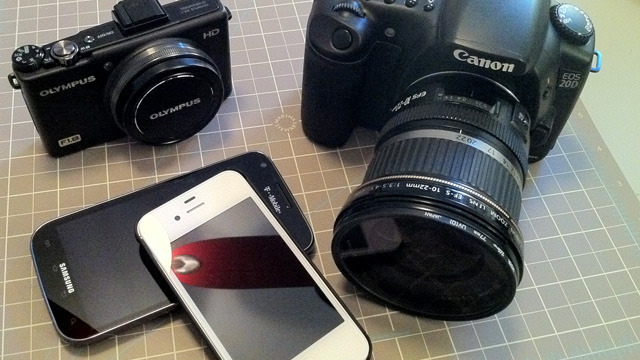
When Apple announced the iPhone 4S, the company certainly talked up the improvements made to the smartphone's integrated camera hardware. With 8 megapixels of resolution, a redesigned lens, and enhancements to its software, it certainly meets or exceeds the needs of most casual shooters.
Still, we here at Ars have received plenty of questions to the effect of, "can the iPhone 4S replace a 'real' camera?" That's actually a hard question to answer, because individual needs vary widely. Would a professional photographer replace her trusty DSLR with an iPhone 4S? No. But, might a casual snap shooter replace a pocket camera with an iPhone 4S? It's pretty likely.
Making a decision to ditch your camera for a smartphone is always going to be a matter of personal preference and a trade-off between convenience versus quality. With that in mind, we set out with a stable of cameras to give as fair a comparison as possible. Along with an iPhone 4S, we also took sample shots with a 5MP iPhone 4, an 8MP Samsung Galaxy SII, an 8MP Canon 20D, and a 10MP Olympus XZ-1.
There are two things we did not do, however. For one, we didn't compare every generation of iPhone. Camera+ developer Lisa Bettany already put together a really thorough comparison already, and suffice to say if you have anything older than an iPhone 4, be prepared to be blown away with the results from an iPhone 4S. If you already have an iPhone 4, the improvements to image quality are a little more subtle. But as we noted in our iPhone 4S review, the speed of the camera hardware and software is significantly improved; this alone is a significant factor that improves usability.

The other thing we didn't do was compare the video capabilities of the iPhone 4S. We already found the iPhone 4's 720p recording ability to be sufficient for casual use, and at least one filmmaker managed to shoot an entire film using iPhone 4s. The iPhone 4S steps that up to 1080p resolution, and some curious filmmakers at Robino Films found that in static, well-lit scenes, it compares favorably to a Canon 5D mkII. Rolling shutter effects will be a problem, and lowlight shooting introduces some artifacts, but overall the hardware performs well shooting video.
What we were interested in was evaluating the iPhone 4S as a still camera that could possibly replace a 'real' digital camera. To try and keep things as fair as possible, our Canon 20D was outfitted with a Canon 10-22mm EF-S lens was set to 22mm (a roughly 35mm equivalent) and left at f/4.5. Exposure was set automatically using aperture priority, just as most smartphones do. ISO was set manually (the 20D doesn't have auto ISO available in aperture priority mode) but was set to our best guess for the situation at hand.
Likewise, the Olympus was put into aperture priority mode, with its aperture set to f/2.5—similar to the smartphones we compared against. ISO was set automatically, and the lens was left all the way at the wide end—roughly 28mm focal length equivalent.
We took a series of subjects in a couple different lighting scenarios: flowers in outdoor lighting, a building at sunset, and some shots in very low indoor lighting at home and at a bar. We'll show you our comparison shots, noting the performance in each case as well as considering what each device was like to carry, pull out, set up, and take each shot.
Outdoors
We took our band of cameras outside during a brisk autumn afternoon with a clear blue sky to capture some images in bright light. First up is a series of photos taken of a flower arrangement. 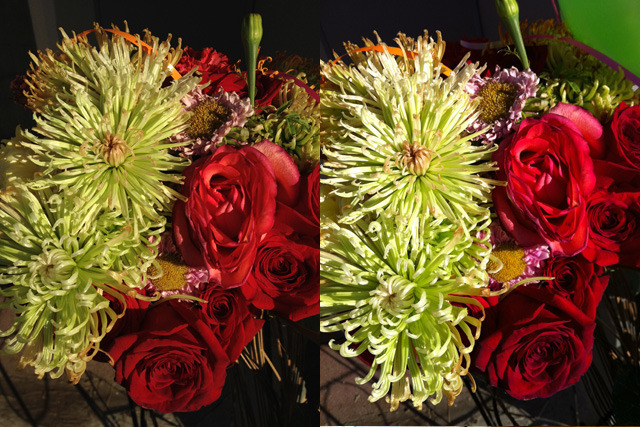
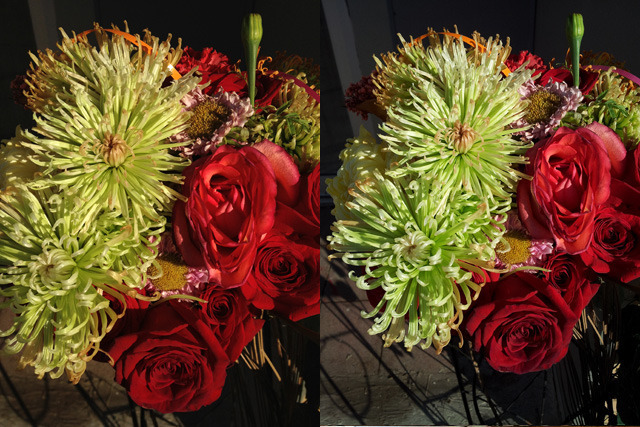

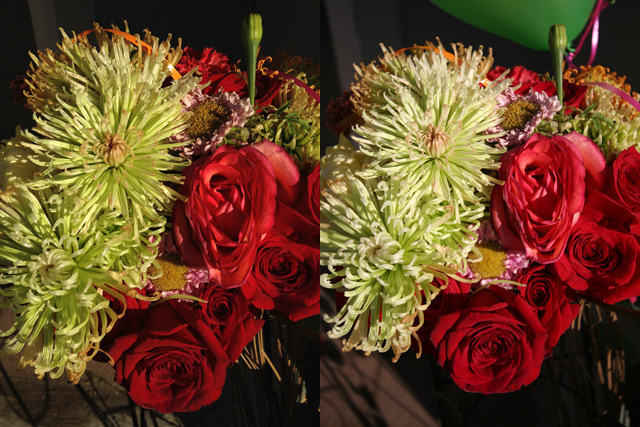
Here you can see the cameras capturing lots of color. Directly comparing the iPhone 4S to the iPhone 4 in the first image, there are two important factors to notice about the improved camera: a greater dynamic range and a tendency to keep colors—especially reds—from over-saturating.
Apple claims to have improved white balance in the 4S, and as such, its images tend to be a little less cold in regular lighting; they show a little less yellow (as we'll see later) under indoor tungsten lighting compared to the iPhone 4. It's difficult to say for sure why these improvements couldn't be passed on to the iPhone 4 with software, but it's likely that the white balance improvements are at least partially due to the new 8MP sensor and its hybrid IR filter.
Our relatively high-end point-and-shoot, the Olympus XZ-1, over-exposed the image quite a bit. It's hard to say what tripped up its exposure system, but suffice it to say, having a more expensive "real" camera doesn't automatically guarantee better results. The XZ-1 has the benefit of offering a variety of manual controls, including ISO adjustments, exposure compensation, and manual exposure control that would let us dial in a better exposure if that's what we wanted.
The iPhone 4S, on the other hand, has no such control. Tapping around different areas of the viewfinder will bias the auto-exposure system for that particular part of the image, however, so there is a way to slightly override it. Still, we found that iPhone would generally nail the exposure about nine times out of ten without intervention.
At screen sizes, there really isn't much difference between the iPhone 4S, the Galaxy SII, and the Canon 20D. We note that the exposure and dynamic range of the Galaxy SII is more like the iPhone 4, while the Canon 20D's rendering is more like that of the iPhone 4S.
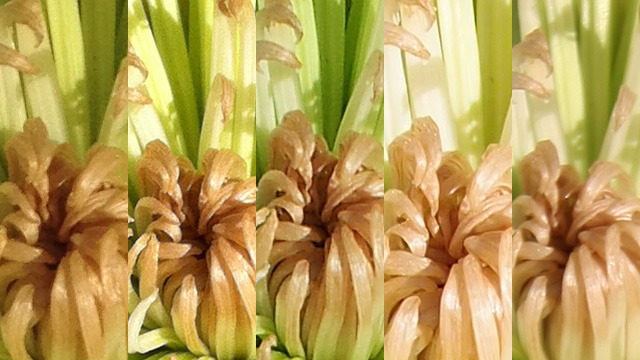
Looking closer at 100 percent crops of each image—pixel peepers rejoice!—the differences are still subtle, but the iPhone 4S and iPhone 4 are clearly noisier than the Olympus or the Canon. The Galaxy SII shows signs of aggressive noise reduction that leaves odd artifacts, though at screen sizes or in smaller prints, these won't likely be noticeable. Both the iPhone 4S and Canon 20D show a little blurriness, but given the high winds on that particular day, I attribute this to a bit of motion blur, as other details in the image are sharp.
reader comments
196